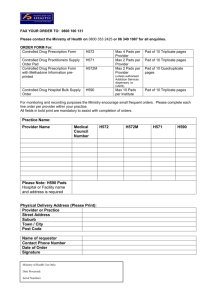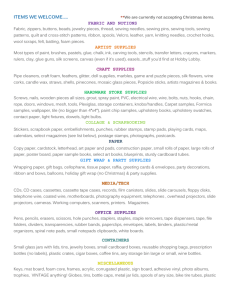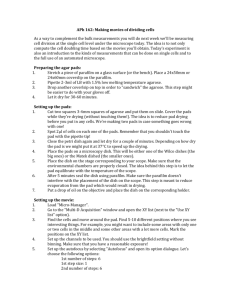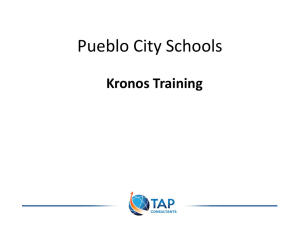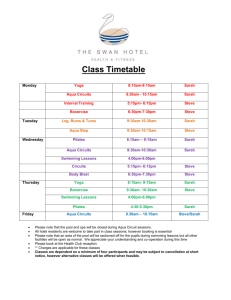Instructor Training Course Manual
advertisement
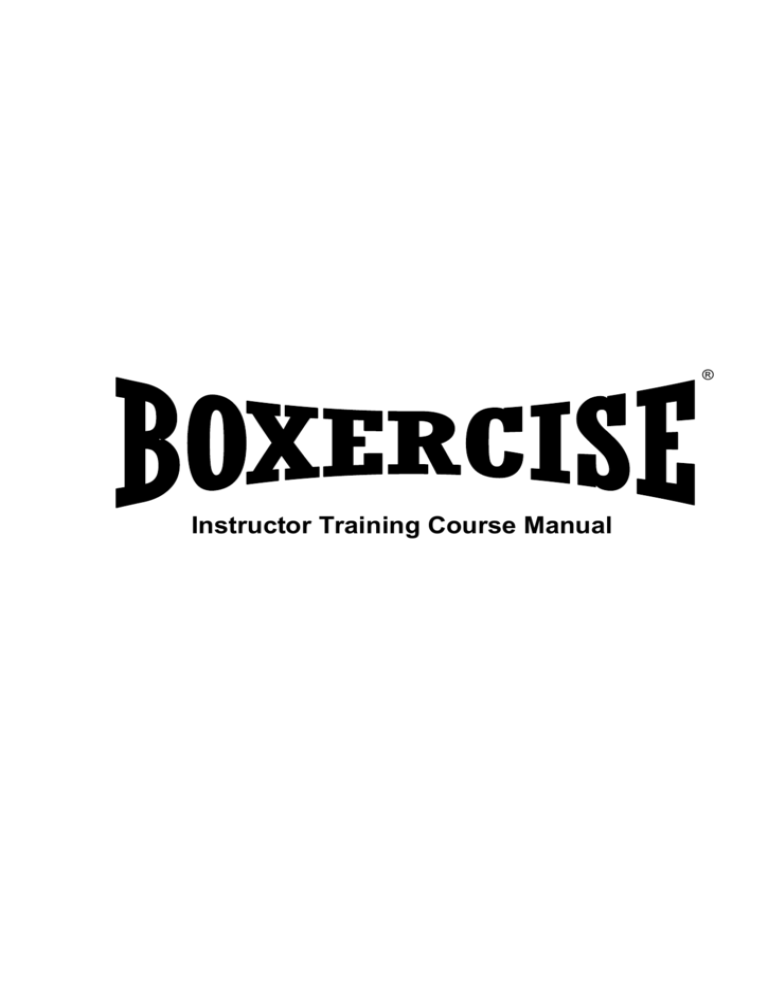
® Instructor Training Course Manual CONTENTS FOREWORD INTRODUCTION THE CONCEPT OF BOXERCISE INJURY PREVENTION - The Hand & Wrist - The Elbow - The Knee SAFETY - Venue EQUIPMENT - Focus Pads - Bag Mitts & Sparring Gloves - Handwraps - Punch Bags THE PUNCHES - Stance - Guard & Movement - The Straight Punches - The Head Hooks - The Body Hooks - The Uppercuts THE FOCUS PADS - Coaching Points - The Straight Punches - The Head Hooks - The Body Hooks - The Uppercuts COACHING THE BOXERCISE CLASS - The Warm Up - Sample Choreography for Aerobic Warm Up - Mobility - Stretching - Aerobic Style Class - Circuit Style Class - Coached Style Class - Beasting Style Class CLASS EXAMPLES ODD NUMBERED BOXERCISE CLASS MUSIC LEGALITIES STARTING YOUR FIRST CLASS GLOSSARY 3 4 5 6 6 7 7 8 9 10 11 12 13 14 14 15 15 16 16 17 17 17 18 19 21 22 23 24 24 24 25 26 27 28 30 31 Foreword Upon successful completion of the Boxercise Instructor Training course each delegate receives a numbered certificate and a photograph ID card which coincides with a database entry on the Register of Approved Boxercise Instructors. This database is held at Head Office, Millstone House, Main Street, Mowsley, Leicestershire, LE17 6NT Boxercise is a Registered Trademark. Only holders of a Boxercise Approved certificate and paying their Annual Licence Fee to remain registered are authorised to use the name Boxercise to promote their classes and advertise as an approved Boxercise Instructor. THIS DOCUMENT MAY NOT BE REPRODUCED WITHOUT PERMISSION FROM BOXERCISE. You have signed to state that you understand that Boxercise is a Registered Trademark. Number 2194200 and E2955961 (European trademark). 1 2 3 4 5 6 7 8 9 10 I understand that successful completion of this course entitles me to teach a class and call it Boxercise. I may not teach anyone else to teach this exercise concept whether they call their class Boxercise or any other similar name. No person may stand in for my class and call it Boxercise unless they are also a Registered Boxercise Instructor. I will not photocopy or pass on any information held in the course manual to any person. I understand that it is my responsibility to pay my annual licence fees to Boxercise in order to remain registered as a Boxercise Instructor and may only use the name Boxercise as long as I remain a Registered Boxercise Instructor. It is your responsibility to cancel the standing order at your bank if you cease to teach Boxercise and no refunds will be given. I will not set up in competition with Boxercise or teach ANY similarly Boxing or Martial Arts based concept via an Instructor Training course to other persons. You should send back your ID card each year for renewal; certificates are not normally renewed as the ID card is harder to copy. If a new certificate is required please enclose an A4 sized SAE and send to head office. Allow 2 weeks for return. The Boxercise newsletter is sent out via email only to those instructors registered on our website who have filled in the email field. You may use the Boxercise logo (available in the Instructor area of the website) on your website and publicity material. If you wish to use the logo on a banner or on a t-shirt we will usually grant permission but ONLY after you have submitted a PROOF to us accompanied by how many units you wish to produce. We will then sign and send back to you stating how many units you have permission to manufacture. NOTE. No person may sell at a profit any clothing or other items using the Boxercise name or logo. Boxercise is a Registered Trademark of Boxercise Corporation. Please understand that breach of the above regulations contravenes Statutory Trademark Rights owned by Boxercise and renders you liable for prosecution. Boxercise will vigorously protect its Intellectual Property Rights and does not provide services under any other name. Introduction As you are now aware, there is little opportunity to take notes during the Boxercise Instructor course. Our practical ‘hands on’ approach has been designed to maximise the specific coaching skills required for this very physical form of activity. This manual therefore acts as a detailed reference of all that you have learned during the Boxercise Instructor Training course. This manual is supported by the course refresher DVD you have also received. There are further opportunities to develop your skills by attending one of our supplementary courses. There is a summary of each of these courses below but please call head office if you have any specific questions or if you would like to book on to a course. KickBoxercise – teaching you basic elbow strikes, knees and kicks to add in to your Boxercise classes and challenge your clients further. You will also receive a course refresher video and a PDF manual covering all the essential knowledge on the KickBoxercise course. (Video and PDF will be available in the instructor’s area of the website after completion of the course) PT/Advanced Skills Course – this course starts where your Boxercise course finishes. We will teach you advanced footwork, defensive moves, counterpunching and how to put it all together. You will take your own notes on this course and will gain access to the course refresher video via the instructor’s area of the website after completion of the course. Boxercise for Kids – this course covers how to adapt your Boxercise session for children, covering all four key stages and specific requirements for training each age group. A hard copy manual is included in this course and you will take your own notes to supplement this. Advanced Instructor Status – This is a supplementary certificate awarded to those instructors who achieve over 80% in all three of the Boxercise, KickBoxercise and the PT/Advanced Skills course. Section 1 1992, 2000, 2013 Boxercise Ltd 4 The Concept of Boxercise Boxercise follows the methods employed in boxing as closely as possible whilst ensuring the maximum amount of safety and exercise benefit to the client. Boxercise has been designed to incorporate active contact without any physical contact. It must be stressed that we are NOT teaching the sport of boxing and we are NOT instructing in the art of self-defence. Boxercise enables the instructor to coach, teach and instruct in a controlled environment. As you have learnt on your course there are four main ways of teaching Boxercise – aerobics, circuits, coached pads and beasting style. Whichever style you choose to teach remember the golden rule – make your class as boxing oriented as possible; people expect to hit stuff in a Boxercise class and hitting the pads is the bit people enjoy the most. Boxercise is also great for PT – get your clients hooked on pad work and keep them forever! They can never go away and do pad work on their own so this is a great way of retaining loyal clients. What are the advantages of Boxercise for general fitness training? It covers all aspects of activity – aerobic and anaerobic It develops skills including hand-eye coordination, balance, timing and technique It works all major muscle groups It enhances range of movement, when technique is performed correctly It is suitable for both sexes, all ages and levels of ability It is a great stress buster It’s fun! Section 1 1992, 2000, 2013 Boxercise Ltd 5 Injury Prevention and Safety With careful instruction and effective coaching of good technique, the risk of injury is greatly reduced. However, as contact forms the basis of this form of activity, there are several areas that need to be identified as potential points of injury. The Hand and Wrist II III IV The majority of injuries that occur to the hand are often the result of incorrect wrist position. When punching correctly the wrist is flat and in line with the forearm enabling the majority of the force to be absorbed by the longer shaft of the metacarpals (II-V) displacing the force evenly throughout the hand. Injury occurs when extension or flexion of the wrist transfers uneven force throughout the hand and wrist. V I Phalanges Metacarpal Scaphoid Radius Ulna Injury can also occur in beginners when the hook punch is performed with the palm facing down. If the punch is mis-timed it can cause the scaphoid or fifth metacarpal to become compressed causing a break or fracture. This is why we recommend performing the hook punch with the palm facing in for beginners. The Elbow The two areas of concern are the medial and lateral epicondyle. Any activity that involves gripping such as punching or holding a pad causes the muscles in the forearm to contract. These muscles are inserted into the distal end of the humerus on its medial and lateral sides. When holding the pads for the hook punches remember to keep your elbows slightly bent and offer a little resistance but do not try to stop the punch. Medial Epicondyle Radius Lateral Epicondyle Ulna As a pad holder you should make sure you set the correct reach for your client as holding the pad too far away will result in them locking the arm out, or even over extending as they throw punches 1 and 2. Section 1 1992, 2000, 2013 Boxercise Ltd 6 The Knee The main safety point to remember regarding the knee is to pivot on the ball of the back foot when throwing punch number 2. Leaving the back heel down will lead to stress occurring in the medial collateral ligament. Lateral Collateral Ligament Medial Collateral Ligament Patella Safety The actual location for any fitness class is very important. When undertaking a Boxercise class, particular areas of concern include: Flooring – An uneven floor can account for many ankle and knee injuries. A carpeted floor may also cause problems if the carpet is thick. The feet may not be able to pivot when punching which may cause the ankles and knees to twist unnecessarily. If hanging a punch bag; first ensure that the walls are solid if drilling a bracket into the wall. If hanging a bag off the ceiling check that the ceiling is solid or contains beams no higher than about 12 feet from which to hang it. If the ceiling is suspended you cannot use it to hang a bag - use the walls or a free standing frame. Do not overpopulate your class. Remember that swinging bags, skipping ropes and pad stations take up more room than normal circuit stations. As a general rule, stations such as a hanging bag or a skipping rope will take up between 2 and 3 standard circuit stations. If you can fit around 20 people in the room for a circuit class, you will be able to fit around 14 to 16 people in a Boxercise class. Section 1 1992, 2000, 2013 Boxercise Ltd 7 Equipment Good quality equipment is essential to protect both the puncher and pad holder but ONLY good technique can prevent injury. Focus Pads (Hook & Jab Pads) The pad is the main tool of the coach bringing structure and versatility to the workout. Shock absorption, comfort and quality are the major considerations when purchasing this item. Important things to remember when purchasing your focus pads: Curved focus pads are much more comfortable to wear because they allow your hand to sit in a more anatomically correct position enabling you to ‘catch’ the punch. The dot MUST be in the centre of the palm of your hand (not the pad) and should be clearly visible i.e. yellow on blue for contrast. If the dot is too high or too low and the puncher connects with the dot, the pad will tilt causing possible injury to the wrist. The thicker the focus pad the more shock absorption it will provide. The heel of the focus pad should always remain in contact with your wrist - a thicker section at the bottom of the focus pad will allow this to happen. A gator that covers your fingers is safer during more advanced work when you may be throwing the focus pad back to your client. Focus pads come in PU (polyurethane) or leather. We recommend PU for classes but most PT’s prefer leather focus pads for their own pair. Section 1 1992, 2000, 2013 Boxercise Ltd 8 Gloves Gloves will either be Bag Mitts or Sparring Gloves – there are some key differences between the two styles to bear in mind when purchasing. Bag Mitts Thumb is not padded and not attached to the glove. Stitching over the whole glove (usually). Sufficient padding to protect the knuckles. Once you can feel the outline of the knuckles you should replace bag mitts. Only to be used for working on focus pads or punchbag – NOT for sparring. Bag mitts come in sizes – small – extra-large. Boxercise supply medium and large sizes as these will fit the majority of class participants. Sparring Gloves Thumb is padded and attached to the glove. No stitching. Heavily padded for greater protection. Can be used for focus pad or punchbag work and can be used for sparring Remember Boxercise instructors are NOT trained to teach sparring. Can be secured at the wrist by Velcro or lace-up (traditional boxing gloves) – Velcro is recommended as it is quick and easy to un-do and do up. Sparring gloves are sized according to weight i.e. 10oz & 12oz NB. Bag mitts and sparring gloves come in PU (polyurethane) or leather. PU is designed primarily for home use and will not stand up to the rigours of a Boxercise class. We recommend leather for Boxercise classes NB. Sparring gloves are pre-formed in the shape of a fist so are not suitable for use for those with small hands/children. You should therefore choose bag mitts because even if the hand is too small inside the glove they can still make a proper fist. Section 1 1992, 2000, 2013 Boxercise Ltd 9 Handwraps The hands are wrapped for three main reasons, namely: To provide a hygiene barrier (and keep your kit fresher for longer). To protect the small bones in the hand from impact. Because they look cool, enhancing clients experience of the Boxercise class! For those people who regularly attend a Boxercise class, we strongly recommend that they purchase their own herring bone bandages. A shortened (1.5m) wrap is recommended for class use as they are quick and simple to put on. Check out our video tutorial here http://www.youtube.com/watch?v=yK2WazhnDt8 Step – by – step guide First remember to remove watches and rings as they may break or get lost inside the gloves and pads. 1. Spread the fingers. Pull across the back of hand 2. Circle the wrist 2-4 times 3. From base of thumb pull diagonally to knuckle of little finger 5. Pull from thumb and forefinger diagonally to wrist 6. Encircle wrist to finish Figure 1 4. Circle knuckles 2-4 times Section 1 1992, 2000, 2013 Boxercise Ltd 10 Punchbags Punchbags come in a variety of materials. Boxercise make two types of punchbag- a PU punchbag and a leather punchbag. Leather is the stronger and better material but PU punchbags provide excellent quality at a reduced price. Punchbags are excellent for a tough boxing workout providing both cardiovascular and resistance work. In inexperienced hands a punchbag can be dangerous so please ensure you have qualified tuition on how to use it before doing so. Please refer to the Boxercise Skills & Drills DVD if you intend to use a punchbag in your sessions. Also you MUST make sure you use good boxing gloves with a heavy bag. We would recommend using sparring gloves for this purpose. NB. Absolute beginners should not use a punchbag. Boxercise recommend that participants have done at least 6 weeks practice on the focus pads first OR when they can consistently achieve a gunshot sound on the pads. Section 1 1992, 2000, 2013 Boxercise Ltd 11 The Punches Footwork Stance The correct Boxercise stance creates a firm base which gives stability, balance and a position that enables free flowing movement. Class participants should adopt a stance where their dominant hand is their back hand. Orthodox (right handed) = right hand is the back hand. Southpaw (left handed) = left hand is the back hand. To adopt the correct stance: Shoulder Width Place the feet shoulder width apart. Take one walking pace forward. Maintain shoulder width position of feet. Turn the back foot out at a 45 degree angle and slightly bend the knees. Walking Pace Balance Allow the body weight to be evenly supported on both feet keeping the knees slightly flexed. Lean over the front foot, the back foot and from side to side to show how the stance allows all round movement and to check the balance of the individuals in the class. If client can’t transfer weight side-to-side their stance is too narrow. Section 1 1992, 2000, 2013 Boxercise Ltd 12 The Guard Straighten the arms above the head with the hands open. Make a fist with the thumb OUTSIDE the fingers. Drop the arms straight in front of you and turn the hands to the side (as if holding on to a car steering wheel). Relax the shoulders and pull the arms into the body close to the ribs with the hands next to the cheeks. Wrists should be flat and palms face towards each other not towards you. Movement When moving it is important to remain in the Boxercise stance at all times. This will maximise balance, stability and safety when it is time to stop and punch. Once the basic movement has been mastered, the heels raise and movement can speed up by pushing off the balls of the feet in a shuffling action; ensure clients do not ‘skip’ when moving faster. Remember that the feet must never meet or cross when moving. To move forwards, lead with the front foot To move backwards, lead with the back foot To move left, lead with the left foot To move right, lead with the right foot Always remember to move-STOP-punch You may use lines on the floor as a visual aid to keep the feet apart. The Boxercise Footwork Training System does this with 43 separate footwork training drills. For more information visit our website: D A . B C http://boxercise.co.uk/equipment/footwork_training_system.php4 Section 1 1992, 2000, 2013 Boxercise Ltd 13 The Boxercise punches have been modified slightly to allow the novice to punch safely and effectively. The technique should be smooth and flowing enabling the participant to expend energy in a controlled manner. The shoulders should remain level at all times and movement should involve the legs, hips and torso. Remember to always refer to the punches as either lead hand or back hand – NEVER left and right. The Straight Punches Lead Hand Back Hand Lead Hand Twist the body (turn the hip and shoulder simultaneously) Extend the arm straight in front of you Return the hand to the guard position. Back Hand Lift on to the ball of the back foot. Turn the body, pivot the back foot and extend the back arm in front of you. Return the hand to the guard position. Safety Points: Wrist flat, elbow 95% of reach, palm facing down, pivot back foot. Lead Hand Back Hand The Head Hooks Lead Hand Twist (front shoulder back) Lift elbow Turn the body Return the hand to the guard position Back Hand Lift on to ball of back foot Lift elbow Turn the body Return the hand to the guard position Safety Points: Palm facing in, elbow and wrist at shoulder height, pivot back foot. Section 1 1992, 2000, 2013 Boxercise Ltd 14 The Body Hooks Lead Hand Lead Hand Bend the knees Bring arm round in the hook position Back Hand Stay down Pivot round on back foot Bring arm round in the hook position Safety points: Palm facing in, forearm parallel to floor, back flat, bum tucked in. Only dip down one head height. The Uppercuts Lunge Down Push Up Lead Hand In guard turn the palm to face body Bend the knees Push up from the legs and push the arm straight up so the hand is in line with the top of the head Back Hand Repeat as above Remember that about 80% of the movement comes from the legs and only 20% from the arms. Safety points: Palm facing in, forearm remains vertical & wrist flat, watch out for ‘scooping’ the arms or ‘bicep curl’ uppercuts. Section 1 1992, 2000, 2013 Boxercise Ltd 15 The Focus Pads The pads form an essential part of any Boxercise class and guarantee one to one instruction with all who partake in the class. Padwork is the closest your class will ever get to actual boxing without any physical contact. Main points to remember: Measuring up correctly is crucial – use punch number one to measure up and ensure the punchers arm is at 95% of reach. The pad holder is always in control and for this reason anything other than the basic skills should initially be left to the Boxercise instructor. Ensure that the pad holder places the SAME FOOT forward as the puncher to avoid foot contact and injury. This stance also reminds the pad holder which hand the puncher leads with. Adopt a firm Boxercise stance at all times and use both the arms and legs as shock absorbers. Maintain correct pad height and width that is based on the puncher and not the pad holder. When moving or talking, always bring the pads back to the body with the dot facing away from the puncher. Do not provide a visible target for the puncher if you do not want them to punch. The pad holder should offer some resistance but should not try to stop the punch or meet it. Lean slightly forward; NEVER lean backwards as it compresses your lower spine and places stress through the whole lower back area. The Straight Punches Keep the pad flat with the arm tucked into your side; in line with your forearm, elbow and wrist. Pad holders wrist should be FLAT. Pads should be held at SHOULDER height of PUNCHER. Pads should be no wider than the shoulders of the pad holder. Display one pad at a time to the novice introducing two pads when correct technique and ability have been demonstrated. Section 1 1992, 2000, 2013 Boxercise Ltd 16 The Head Hooks Push the pads forward and turn them on the side. The dot on the pad should remain at the same height as the straight punches i.e. SHOULDER height of the PUNCHER. Pads should be approximately one forearm plus a fist width. Offer some resistance to the punch but DO NOT try to stop the punch. The Body Hooks Pads stay on the side. The pad is in line with the tip of the punchers elbow (ensuring their guard is up). Offer some resistance to the punch but DO NOT try to stop the punch. The Uppercuts Bring the pad back up to SHOULDER height of the puncher (based on their shoulder height when standing). Keep the pad surface face down so that the puncher cannot see the dot until they dip underneath. If holding both pads up together they should touch together. Section 1 1992, 2000, 2013 Boxercise Ltd 17 Coaching Improving your coaching skills is one of the main focuses of the Boxercise course. Here are a few pointers to help you remember the skills we taught you on the course. When teaching at the front of the group: Mirror the group - i.e. most of the group will generally be orthodox so you should teach in southpaw. Coaching angles – change your position at the front of the class so you are not always teaching from the centre. Side-on demos – turn sideways to show key safety points such as flat wrists and the back foot pivot. When coaching a client on the pads: Don’t just rely on ‘telling’ the client when they have done something wrong (verbal feedback). If you have a mirror available give them a visual demonstration to show them correct technique – stand next to them on their open-side so they can see you clearly (visual feedback). If you don’t have a mirror available stand on their open side but slightly in front of them so they can see the demonstration clearly. Use kinaesthetic feedback to reinforce correct technique. Use kinaesthetic feedback to find a coaching keyword which they associate with the correct movement – remember it is the client who must choose the keyword NOT the coach. Once you know what type of learner your client is you will be able to use the relevant type of feedback quickly and easily each time you have to correct a fault i.e. if they are a strong visual learner the visual demo may be enough that you don’t need kinaesthetic and vice versa. Section 1 1992, 2000, 2013 Boxercise Ltd 18 The Boxercise Class As you have learnt on your course there are four main ways of teaching a Boxercise class – Aerobics, Circuits, Coached and Beasting. We always recommend that you teach the style that suits your personality best – teach according to your strengths. For example if you hate aerobics you don’t ever have to include this in your classes but if you are really good at teaching to music this can be a really enjoyable way to warm up your class. The Warm Up The following examples cover the four most common ways of warming up your class. Circuit Style (5 - 10 mins) Easy to teach Effective warm up and mobilisation Gradually increase intensity - start walking, through jogging up to running. Try to avoid just running round in a circle but get them to move around randomly so they pass each other, this is much more sociable allowing for more interaction between class members. Whilst moving them around guide them through various other movements e.g. arm circles, touch the floor, jump up, etc. Make it fun – get them to do partner activity as they move around e.g. high fives, low fives. Try calling opposites – give them some actions to perform but they have to do the opposite to what you call out – punishment for getting it wrong e.g. a burpee before they join back in. Foot Movement (5 – 10 mins) Face the group – mirror the majority for ease of learning, i.e. for most of us this means we need practice demonstrating in the southpaw stance as most class participants will be orthodox. Coach the class at walking pace so you can clearly spot common mistakes and correct them whilst slowly elevating the heart rate. Gives you the best chance to teach good technique right from the start of the class. This approach works very well with a novice class as it quickly establishes the move-stop-punch principle. Also works well as a second pulse raiser (performed after circuit style warm up as above). Section 1 1992, 2000, 2013 Boxercise Ltd 19 Boxercise Aerobics (5 – 15 mins) Great fun to teach and participate in if this is something you are good at Use music that is slow enough to still allow good technique to be performed e.g. 128bpm Can be used as first or second pulse raiser or even as a nice cool-down to incorporate final stretches. The aerobic routine example on page 21 uses basic choreography that is easy to follow and repeat. Remember that most people attending a Boxercise class will be expecting to punch the pads rather than follow a routine to music. Keep the moves simple and increase the intensity, varying the punching movement to keep it fresh. The punches do not have to be given in groups of four; however, this number fits in easily with a set beat and will not make the moves over-complicated for the novice. Boxing Games (5-10 minutes) Games should reinforce good Boxercise technique whilst being FUN! Games should be progressive - warming up the body gradually. The games below (and more) are learned on the Boxercise for Kids course but remember that adults like to have fun just as much as kids so games work well with not so young class members too! Boxercise version of Dodgeball Stuck in the (Boxercise) Mud Boxercise Ball Throw Circle Section 1 1992, 2000, 2013 Boxercise Ltd 20 Boxercise Aerobic Choreography Novice Level Aerobic Routine (120-140bpm; Duration up to10 minutes) BREAKDOWN TEACHING POINTS Straight Punches left and right – 4 count, twist 5-6-7-8 Emphasise the twist of the shoulders and palm down, arm 95% straight. Keep the punching slow till they follow the beat. When they can follow the beat punch double time with two twists to represent 5-6-7-8. Step forward and back – one pace Don’t allow the feet to touch, remember this is not step tap; it is one step forward and back in the Boxercise stance. Talk over the top of the basic movement, cueing the next set of moves with 4,3,2,1… Forward 4 – Bounce for 4 Backward 4 – Bounce for 4 In the Boxercise stance move the group towards you, moving forward (1), 2, 3, 4 and stop, 5, 6, 7, 8 then backward(1), 2, 3, 4 and stop, 5, 6, 7, 8. This approach enables you to emphasise and observe balance and stability when stopping before you introduce the punches. Bounce on the spot, flexing the knees with the feet remaining on the floor to take shock from the knees and keep the group moving. Repeat 3 times. Bounce forward and back – one pace Now that the group are familiar with the movement pattern and their pulse has been slightly elevated, increase the tempo by lightly bouncing from foot to foot. The knees should flex and the feet move only a small amount to reduce impact. Forward 4 – 4 Straight Punches Backward 4 – 4 Straight Punches As above adding four straight punches when stopping, now at the new tempo. Still emphasise palm down and 95% reach when punching, twisting through the shoulders and hips when punching. Repeat 3 times. Now return to bounce forward and back one pace. Bounce left and right – one pace Cue 4,3,2,1 and now in the Boxercise stance bounce lightly from left to right. The feet must not cross or meet. This new movement prepares the group to move left and right in their stance Left 4 – 4 Head Hooks Right 4 – 4 Head Hooks In weeks 1 and 2 of the class, the straight punch would be used instead of the head hook. Once the head hook has been introduced, associate the new punch with a change in direction, namely, forward and back – straight punches, left and right – hooked punches. This brings familiarity to the movement patterns and allows the group to progress. The Body Hooks and Uppercuts can be introduced in the same manner. Teach them in a set block, namely, forward and back - body hooks, left and right – uppercuts. Once all eight punches have been introduced, try adding a punch for each direction, namely, forward – straights, backward – head hooks, left – body hooks, right – uppercuts. Section 1 1992, 2000, 2013 Boxercise Ltd 21 Mobility Ideas This is by no means a comprehensive list but you should include some specific mobility for the shoulders, hips and spine in your warm up section. 1. Shoulder Rolls 2. Neck Mobility Shoulder Rolls • • Relax your arms by your sides Raise your shoulders to your ears and then rotate them forwards x 10 Now rotate the shoulders backwards x 10 • Neck Mobility • • Relax your arms by your sides Turn your head to one side until you feel the neck muscles stretching. Hold the stretch for a count of one. Turn the head to the other side and repeat. Repeat x 10 to each side. • • 3. Shoulder Rotations 4. Trunk Rotations Shoulder Rotations • Make a W shape with the arms as shown Turn the arms down so the palms face the floor Draw the arms back up to the W shape Repeat x 10, moving slowly through the range • • • Trunk Rotations • • • Stand with the feet shoulder width apart and the knees slightly bent Twist to the side leading with the opposite arm allowing the heel to rise as you twist. Repeat x 10 each side Other mobility suggestions: Arm Circles, Hip Rotations, Ankle Rotations, Push press ups off the wall (to warm up the shoulders). Section 1 1992, 2000, 2013 Boxercise Ltd 22 Stretching Ideas Again this is not a comprehensive list but you should include some stretches during the cool-down section of your Boxercise class. 1. Quadriceps 2. Calves Quadriceps • • Bend one leg at 90 degrees taking hold of either the toes or the heel Hold for a count of ten and repeat with the other leg Calves • • • 3. Hamstrings Step one foot back in a long lunge position Keep the back heel down and bend the front leg Hold for a count of ten and repeat with the other leg Hamstrings • • • Transfer your weight onto your back leg Straighten the front leg, sitting on the back leg, dipping the chest down Hold for a count of ten and repeat with the other leg Other stretching ideas: Chest stretch, Shoulder stretch, Triceps stretch, Side Bends, Lats stretch General Points to Remember Warm up stretches should be held for 8-10 seconds Cool-down stretches should be held for 30 seconds Don’t bounce or force stretches A sufficient warm should always precede any stretching Keep the participants moving between warm up stretches. Body temperature and heart rate should not drop too much during this section. Section 1 1992, 2000, 2013 Boxercise Ltd 23 Class Ideas As discussed on the course there are four main ways of teaching a Boxercise class. We recommend that you teach the style that suits your strengths and try mixing and matching the styles. Aerobic Style Class See page 21 for some example choreography, Boxercise Aerobics is best used as a fun warm up or cool down rather than running the whole class this way as most people will expect to hit the pads when they come to a Boxercise class. Circuit Style Class Great for teaching to large groups as you don’t need pads and gloves for all participants. Use your imagination and make the stations as boxing oriented as possible. Skipping. Bob & Weave - (use two handwraps or a piece of rope; anchor at one end and partners take it in turns to hold the other end if you can’t anchor both ends). Give & Take – sit up and pass a medicine ball between partners. One Pad/One Glove – good for abdominal stations and shuttle runs. Step Ups with Punches Shadow Boxing – map it out for beginners so they know exactly what to do. Mini-Circuits – include traditional exercises such as press up, squats etc. but group them into mini-circuits so they only do 10-20 repetitions of each exercise completing 5 or 6 exercises within the 2 minutes. Coached Style Class The best way of putting more boxing into your class. For the traditional format you will need enough pads and gloves for everyone but you don’t necessarily need to run a whole class like this – even just a couple of rounds at the end of the circuit makes a fantastic finisher to your class. You can incorporate coached pads into your class even if you don’t have enough pads and gloves for everyone it just takes a bit more management. There are two ways to do this. 1) Run a circuit around the outside of the room which everyone is going round; certain ‘stations’ direct them into the centre of the room where you guide a small group (maybe 2 or 3 pairs) through a coached round. (Everyone else continues on their circuit station). 2) Split the group in two and put half of them through a coached round whilst the other half do another exercise (that doesn’t require pads and gloves) e.g. an accumulator or fitness challenge. Section 1 1992, 2000, 2013 Boxercise Ltd 24 Beasting Style Class Probably the most fun style of class. Again, for the traditional format you will need enough pads and gloves for everyone but you don’t have to run the whole class like this. Doing a couple of beasting stations at the end of the class is a great fun way to finish them off! We generally advise that all punches done during the beasting section are done for speed rather than power i.e. light, fast punches. Run & Punch – run to partner and throw a set number of punches. Continually run back and forward or give them an exercise (e.g. a burpee) to do before they run again. Crazy Point & Punch – first time run to partner as above but on subsequent runs pad-holders call or point to different punchers so the punchers are always going to a different pad-holder. Very sociable and doesn’t need an even number of participants. Scatter Pads – pad-holders scatter around the room and do star jumps whilst not being punched. Punchers run between them performing 10 or 20 punches when they find a pad-holder. Punching Square – Line pad-holders up at the top of the room in a stance with pad number one up. Punchers run down one side of the room to the first pad and then punch no.1 moving across the line. They then run back down one side of the room (or lunge walk, or bunny hop or forward roll – whatever you decide!) and then do something else across the bottom of the room to finish the square and repeat until the two minutes is up. 10, 20, 30 40, 50 – Puncher starts lying on their back with pad holder kneeling over them holding pads just above the knees. Curl up and throw 10 punches, then both partners run to the other side of the room and do 10 punches in standing. Run back and do another 10 sit up punches then run back and do 20 standing punches. Repeat until you get to 50 standing up punches. This can either be done for time i.e. just see how close to 50 they can get in the two minutes or as a race i.e. no timer just let them go until one pair win. Grenade – scatter punchers and pad-holders around the room in pairs. Get them to perform a combination. When you shout ‘grenade’ they have to hit the deck and get back up as fast as they can and start punching again. Punching Circle – pad-holders stand in a circle facing outwards. Give each person a different pad position and then the punchers get in front of a pad holder. They punch the pads until you shout ‘change’ when they all move to the left and throw punches again until the change. Abdominals – punchers lay on their backs. Pad-holders kneel at their feet holding the pads just above the punchers knees. Call out an amount of punches – punchers crunch up and throw that amount of punches. The quicker they punch the more rest they get between sets! A beasting station that doesn’t require pads and gloves for everyone. Gun Run – put the class into two (or more) teams. Give each team something to carry e.g. a strike shield, big bag of kit, tackle bag, punch-bag etc. First team member runs whilst carrying the object down to the end of the room, slams it down, kneels on it and gives it 10 punches. They carry it back and pass it to the next team member. First team to finish are the winners! Section 1 1992, 2000, 2013 Boxercise Ltd 25 Class Examples Here are just a few different ways you can incorporate different styles of class into your sessions – use your imagination and remember to teach to your strengths. There is no set format; do what suits your skills, your venue, equipment and participants! All the warm-ups, second pulse raisers and main body sections are interchangeable here. Circuit Style Example (50-60 minutes) incorporating coached and beasting too Warm Up – 5-10 minutes – footwork, re-cap punching technique and footwork and move them around the room in a stance, gradually increasing the intensity. Mobility – 5 minutes Second pulse raiser – 10 minutes – coached pads (2 rounds each). Focus on technique rather than power. Main body of class – 20 minutes – circuit stations in pairs Finisher – 5 minutes – beasting station (1 round each). Focus on speed rather than power. Cool-down – 5-10 minutes – gradually bringing heart rate down and incorporating stretches. Coached Pads Example (50-60 minutes) Warm-up & Mobility – 5-10 minutes – standard circuit style warm-up i.e. walking, then jogging, then running around the room gradually increasing intensity incorporating mobility. Second pulse raiser – 5-10 minutes – footwork drills (as session 1 warm up, can be more advanced incorporating rotational footwork from PT course and anything else to be used in class e.g. defensive moves and pad positions). Main body of class – 20-30 minutes – coached pads in pairs – you’ll need 4 combo’s for a 20 minute block or 6 for 30 minutes. Finisher (if time) – beasting station (1 or 2 rounds each). Cool-down – 5-10 minutes – gradually bringing heart rate down and incorporating stretches. Beasting Class Example (50-60 minutes) Warm Up & Mobility – as per previous two examples or some Boxercise Aerobics if you’re good at it. Second pulse raiser – one of the two examples above or again could be aerobics. Main body of class – 20-30 minutes – working in two teams basically beasting them! Remember each team will repeat each station so each station takes 5 minutes to complete based on 2 minutes on, 30 seconds rest. Core section – 5-10 minutes – if no abdominal stations done in beasting do a specific core section here. Stretches – 5-10 minutes - if on floor for core section you can go straight into stretches to finish. Section 1 1992, 2000, 2013 Boxercise Ltd 26 The Odd Numbered Boxercise Class If you have an odd number of participants and you are teaching a circuit style class you have two options. Option 1 Join in – go round the circuit with one of the participants. Not really an ideal solution as it can be difficult to keep an eye on everyone and your attention tends to be drawn to the person you’re partnering but can be done on the occasional week when you don’t have any new participants. Sometimes your class members like to see you suffering too! Option 2 You will need individual stations with the correct amount of stations to participants. Each person works round the stations on their own. If you want to incorporate punching combinations – the gloves will be one station and the pads will be one station. Whoever is on the pads turns to face the person on the gloves and holds for them to punch. When it is time to change the pad holder moves on to the next station, the puncher moves on to hold the pads for the next person coming along and so on. Below is a very basic example where everyone works individually and only punches when they get to the instructor station. 1. Mini Circuit 2. Wall throw with 10 Press Ups sponge ball 10 Crunches 10 Squats • • 9. Shuttles Step Ups and Dips • • • • • • 4. Focus Pads (Instructor Station) Warm Up – stance & moving 5 mins Stretch 5 mins Pulse Raiser – move-stop-punch 5 mins Time - 1 to 2 minutes 5. Footwork Left 4, 4 hooks Right 4, 4 hooks Recovery - 15 to 30 seconds Class Time 30 - 45 mins Total 45 – 60 mins 8. Punch between legs • 3. Double Step Ups 7. Dumbbell Punches All stations shown require only one person. Nine stations for nine people 6. Skipping If using paired stations only one person moves to the next exercise (max. 18 people) Instructor holding the pads/being a station This can be really beneficial to both you and your participants. It’s not something to be done every week e.g. when you have lots of newbies but is definitely worth doing occasionally. If you also do PT it is a great way of getting new clients and your participants will love the chance to have a go on the pads with the best pad holder in the room! Remember – position yourself in a corner so you can still observe the whole room. Section 1 1992, 2000, 2013 Boxercise Ltd 27 Music Legalities There are three options regarding the music you play in your sessions to make sure you are not breaking the law. 1) Purchase the relevant music licence; most freelance instructors will need a PPL licence. Most freelance instructors won’t need a PRS licence as it is usually the venues responsibility to hold a PRS licence. There is a Mobile Licence available for instructors who use a variety of premises without PRS licences but PRS state they would always licence a premise before individual hirers. - Having a PPL licence means you can play any music in your classes. - However, if you are copying, burning or transferring music from your vinyl, CD, MP3 or CD-G collection onto a digital format such as an MP3 player, flash drive or laptop for use in your professional or semi-professional working life you will need to purchase a ProDub Licence (see below for more details). What does the ProDub Licence include? Copyright in the Musical Work (MCPS) Copyright in the Sound Recording (PPL) VAT Permission to copy your legally-purchased music onto any other format You only pay once for the tracks you copy ProDub: Fitness - Year One, Level One tier starts at £85.11 (+VAT) to copy up to 1,000 tracks. http://www.prsformusic.com/users/recordedmedia/ProDub/Pages/ProDubLicence.aspx 2) Purchase music from a specialist fitness music provider such as www.pureenergydigital.com, www.fitpromusic.com or Multitrax www.exercisemusicshop.com – YOU WILL STILL NEED TO PURCHASE A PPL LICENCE if you take this option but the music is especially made for fitness. - The Boxercise Circuit CD’s – Rock Mix & Dance Mix fall in to this category. 3) Use music in your sessions that does not require a PPL (or PRS) licence from a specialist fitness music company such as www.gymsymphonies.com, www.bodyrockerfitness.com or www.fmgmusic.com (also Multitrax). - The Boxercise Aerobic CD (CDAER) falls in to this category. Section 1 1992, 2000, 2013 Boxercise Ltd 28 PPL/PRS – what’s the difference? PPL and PRS for Music are two separate independent companies and in most instances a licence is required from both organisations for you to legally play recorded music in public (but as stated above it is usually the premises that hold the PRS licence rather than the individual). While both organisations licence the use of music and collect royalties for the music industry, each represents different rights holders and have separate licences, terms and conditions. PPL collects and distributes money for the use of recorded music on behalf of record companies and performers. PRS for Music collects and distributes money for the use of the musical composition and lyrics on behalf of authors, songwriters, composers and publishers. http://www.ppluk.com/I-Play-Music/Businesses/Why-do-I-need-alicence/#doineedalicence PPL – New tariff Under the new tariff the sole responsibility for holding a valid PPL licence for exercise classes in fitness centres will be on the operators of those centres. Fitness instructors will still be required to hold a valid PPL licence for any classes that they operate on premises other than fitness centres (e.g. hired halls, community buildings, offices). IMPORTANT FOR FREELANCE INSTRUCTORS. Please note that all licences due for renewal prior to 1 May 2013 must renew as usual for a full year under the current tariff. Customers will be sent an invoice as usual. A transition process is in operation to ensure there is no overlap in classes covered by both fitness centre and instructor licences at any point. http://www.ppluk.com/I-Play-Music/Businesses/New-Exercise-for-Music-tariff-for-2013/ Boxercise try to keep this information as up to date as possible but please do check the information yourself to make sure you are not breaking the law. The links will take you to the most up to date information. Section 1 1992, 2000, 2013 Boxercise Ltd 29 And finally…..before you start your first class Before setting up your first class there are a few things you’ll need to do, here is a checklist: - 10 hours of practice; watch yourself in a mirror to check your own technique, try and teach fitness instructor friends the punches and then try and teach someone who doesn’t work in the industry e.g. a family member. - Register on the website – you will need to set up your password so that you can access your own listing on the Registered Boxercise Instructor list on the website. You can advertise your class here and provide contact details for the public to contact you. Remember that if you want to be searchable by your location you will need to put your postcode in (or the postcode of where you do your classes). - If you want to receive our email newsletter every two weeks you will need to input your email address in to your website listing if it’s not already there. - The instructors area of the website also contains the following material to help promote your classes: Ready-made promotional posters for Boxercise, KickBoxercise, Boxercise Personal Training and Boxercise for Kids. Loyalty cards – attend 6 classes, get the 7th free OR attend 9 classes get the 10th free – you choose which option you prefer. Boxercise Logo’s – a couple of PDF colour versions suitable for your website/facebook page etc. There is also an Adobe Illustrator version which is for high-quality printing e.g. clothes/banners but please note the trademark information on the website regarding t-shirt printing. (Most home pc’s won’t have the software to view this document but if getting banners made or t-shirts printed they should have the software to use this type of file). You can also access the discounted instructor equipment via the instructor login. Boxercise class start up advice – some hints and tips on how to promote your sessions and retain your class members once you’ve got them! - - Watch the course refresher video – also available in the instructor area of the website. This is a really useful reminder of the techniques learnt on the course and also has some great ideas to incorporate into your class. ‘Like’ our facebook page www.facebook.com/BoxerciseLtd. We often share class ideas and combinations on there to help you develop your Boxercise sessions. Good luck - we love to hear how our instructors are getting on so please keep in touch and let us know! Section 1 1992, 2000, 2013 Boxercise Ltd 30 Glossary Bag Mitts Boxing gloves used in a Boxercise class. Can be used on the heavy bag, floor to ceiling ball, speedball, maize ball and focus pads. Sparring Gloves Much more heavily padded than bag mitts; predominantly used for full contact sparring but can also be used on the focus pads and punch bags. Recommended for use with PT clients. Duck, Slip, Swayback Defensive boxing moves used to avoid punches. Can be used to build more realistic, better flowing, more challenging combinations. These skills are taught on the PT/Advanced Skills course. Focus Pads Hand held pads with a dot in the middle. Used to coach punching technique, build punching combinations and elevate heart rate. An essential part of every Boxercise class. Hand Wrap Cloth bandages, 1.5m in length used to cover the knuckles, thumb and wrist to protect the small bones of the hand and wrist and increase hygiene. Heavy Bag Made from canvas, nylon canvas, PU, PVC or leather. A tubular bag filled with scraps of leather, old clothing or granulated rubberNOT SAND, between 3ft and 6ft in length. The most dangerous piece of equipment in a Boxercise class. Uppercuts should only be thrown by the experienced boxer. Jab & Cross Otherwise referred to in Boxercise as punches 1 and 2 – the Jab is ONLY EVER THE FRONT HAND and the Cross is ONLY EVER THE BACK HAND regardless of what stance the puncher is in. i.e. Orthodox puncher jabs with the left hand and throws the cross with the right hand. A southpaw puncher will do the opposite. Guard Position In a Boxercise stance with the elbows tucked into the ribs; hands just in front of the cheeks with the hands held in fists. Orthodox A right handed puncher. Stands with the left foot forward using the left hand to throw the jab (front hand) and the right hand to throw the cross (back hand). Pivot Turning 90 degrees on the ball of the foot. Southpaw A left handed puncher. Stands with the right foot forward using the right hand to throw the jab (front hand) and the left hand to throw the cross (back hand). Section 1 1992, 2000, 2013 Boxercise Ltd 31
